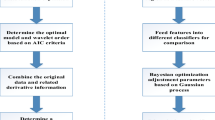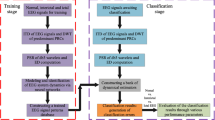Abstract
It has been well over a century since it was discovered that the mammalian brain generates a small but measurable electrical signal. The electroencephalogram ( EEG ) of small animals was measured by Caton in 1875, and in man by Berger in 1925. It had been thought by the mathematician N. Wiener, among others, that generalized harmonic analysis would provide the mathematical tools necessary to penetrate the mysterious relations between the EEG time series and the functioning of the brain. The progress along this path has been slow however, and the understanding and interpretation of EEG’s remain quite elusive.
Access this chapter
Tax calculation will be finalised at checkout
Purchases are for personal use only
Preview
Unable to display preview. Download preview PDF.
Similar content being viewed by others
References
Handbook of Electroencephalography and Clinical Neurophysiol-ogy, Vol. I: Methods of Analysis of Brain Electrical and Magnetic Signals. ( 1987 ) Gevins A., Rémond A. ( eds.), Elsevier, Amsterdam.
Handbook of Electroencephalography and Clinical Neurophysiology, Vol. II: Clinical Applications of Computer Analysis of EEG and Other Neurophysiological Signals. ( 1988 ) Lopes da Silva F. H., Storm van Leeuwen W., Rémond A. (eds.), Elsevier, Amsterdam.
Current Practice of Clinical Electroencephalography, 2nd. ed.(1990 ) Daly D. D., Pedley T. A. ( eds. ), Reven Press Ltd., New York.
Başar E. Dynamics of Sensory and Cognitive Processing by the Brain. Springer Series in Brain Dynamics, Vol. I. Springer-Verlag, Berlin, 1988.
Başar E. and Bullock T. H. Brain Dynamics. Springer Series in Brain Dynamics, Vol. II. Springer-Verlag, Berlin, 1989.
Başar E. Chaos in Brain Function. Springer-Verlag, Berlin, 1990.
West B. J. Fractal Physiology and Chaos in Medicine. Nonlinear Phenomena in Life Science, Vol 1.World Scientific, Singapore, 1990.
Gevins A. S. Overview of Computer Analysis. In Handbook of Electroencephalography and Clinical Neurophysiology, Vol. I: Methods of Analysis of Brain Electrical and Magnetic Signals.( Ref. [1] ), pp. 31–83, 1987.
Lopes da Silva F. a) EEG analysis: theory and practice, b) Computer-assisted EEG diagnosis: pattern recognition in EEG analysis, feature extraction and classification. In Electroen-cephalography: Basic Principles, Clinical Applications and Related Fields. Niedermeyer E. and Lopes da Silva F. ( eds. ), Urban & Schwarzenberg, Baltimore, (a) pp. 685–711, (b) pp. 713-732, 1982.
Gotman J. In Handbook of Electroencephalography and Clinical Neurophysiology, Vol. II: Clinical Applications of Computer Analysis of EEG and Other Neurophysiological Signals. (Ref. [2] ), pp. 546–597, 1988.
Dumermuth G. and Molinari L. Spectral Analysis of EEG Background Activity. In Handbook of Electroencephalography and Clinical Neurophysiology, Vol. I: Methods of Analysis of Brain Electrical and Magnetic Signals. ( Ref. [1] ), pp. 85–130, 1987.
Gotman J. The use of computers in analysis and display of EEG. In Current Practice of Clinical Electroencephalography. ( Ref. [3] ), pp. 51–83, 1990.
Mars N. J. I. and Lopes da Silva F. H. EEG analysis methods based on information theory. In Handbook of Electroencephalography and Clinical Neurophysiology, Vol. I: Methods of Analysis of Brain Electrical and Magnetic Signals.( Ref. [1] ), pp. 297–307, 1987.
Pijn J. P. M. Quantitative Evaluation of EEG Signals in Epilepsy: Nonlinear Associations, Time Delays and Nonlinear Dynamics. Ph.D. Thesis, Universiteit van Amsterdam, 1990.
Beldhis H. J. A., Suzuki T., Pijn J. P. M., Teisman M. and Lopes da Silva F. H. Propagation of epileptiform activity during development of amygdala kindling in rats: linear and non-linear association between ipsi-and contralateral sites. Eur. J. of Neu-roscience 5, 944–954, 1993.
Pijn J. P. M. and Lopes da Silva F. H. Propagation of electrical activity: nonlinear associations and time delays between EEG signals. In Basic Mechanism of the EEG. Zschocke S., Speckmann E. J. ( eds. ), Bishäuser, Boston, 1993.
Babloyantz A. Evidence of chaotic dynamics of brain activity during the sleep cycle. In Dimensions and Entropies in Chaotic Systems. Meyer-Kress G. ( eds. ), Springer-Verlag, Berlin, pp. 241–245, 1986.
Meyer-Kress G. and Layne S. C. Dimensionality of human electroencephalogram. In Perspectives in Biological Dynamics and Theoretical Medicine. Koslow S. H., Mandel A. J., Shlesinger M. F. ( eds. ), Ann. N. Y. Acad. Sci. 504, 1987.
Layne S. C., Meyer-Kress G. and Holzfuss J. Problems associated with dimensional analysis of electroencephalogram data. In Dimensions and Entropies in Chaotic Systems. Meyer-Kress G. ( eds. ), Springer-Verlag, Berlin, pp. 246–256, 1986.
Frank G. W., Lookman T., Nerenberg N. A. H., Essex C., Lemieux J. and Blume W. Chaotic time series analysis of epileptic seizures. Physica D 46, 427–438, 1990.
Gallez D. and Babloyantz A. Lyapunov exponents for nonuni-form attractors. Phys. Lett. 161, 247–254, 1991.
Gallez D. and Babloyantz A. Predictability of human EEG: a dynamical approach. Biol Cybern. 64, 381–391, 1991.
Pijn J. P. N., Van Neerven J., Noest A. and Lopes da Silva F. Chaos or noise in EEG signals; dependence on state and brain site. Electroencephalog. Clin. Neurophysiol. 79, 371–381, 1991.
Iasemidis L. D., Sackellares J. C, Zaveri H. P. and Williams W. J. Phase space topography and the Lyapunov exponent of electrocorticograms in partial seizures. Brain Topography 2, 187–201, 1990.
Lehnetz K. and Elger C. E. Spatio-temporal dynamics of the primary epileptogenic area in temporal lobe epilepsy characterized by neuronal complexity loss. Elec. and Clinical Neurophys. 95, 108–117, 1995.
Blanco S., Costa A., Jacovkis P. and Rosso O. A. Characterization of the dynamical evolution of an epileptic seizure. Proceedings of Primer Coloquio Latinoamericano de Matematica Aplicada a la Industria y la Medicina. ( in press ), 1996.
Blanco S., Kochen S., Quian Quiroga R., Rosso O. A. and Sal-gado P. Characterization of background electrical activity of brain structures by nonlinear dynamical parameters. ( to be published ), 1996
Gabor D. Theory of communication. J. Inst. Elec. Eng. 93, 429–459, 1946.
Blanco S., Quian Quiroga R., Rosso O. A. and Kochen S. Time-frequency analysis of electroencephalogram series. Phys. Rev. E 51 2624–2631, 1995.
Blanco S., D’Attellis C, Isaacson S., Rosso O. A. and Sirne R. O. Time-frequency analysis of electroencephalogram series (II): Gabor and Wavelet Transform. Phys. Rev. E.Physical Rev. E 54, No. 5, 1996.
Blanco S., Kochen S., Rosso 0. A. and Salgado P. Application of the time-frequency analysis to seizure EEG activity in candidates for epileptic surgery. IEEE Eng. Med. Biol. Mag. ( in press ), 1996.
Blanco S., Kochen S., Rosso O. A. and Salgado P. Characterization of epileptic seizure using Gabor Transform. Proceedings of Primer Coloquio Latinoamericano de Matematica Aplicada a la Industria y la Medicina. ( in press ), 1996.
Blanco S., García H., Quian Quiroga R., Romanelli L. and Rosso O. A. Stationarity of the EEG series. IEEE Eng. Med. Biol. Mag. 14, 395–399, 1995.
Caputo J. G. Practical remarks on the estimation of dimension and entropy from experimental data. In Measures of Complexity and Chaos. Abraham N. B., Albano A. M., Passamante A. and Rapp P. ( eds. ) NATO, Series B208, pp. 99–110, 1989.
Gasser T. General characteristic of the EEG as a signal. In EEG Informatics: a Didactic Review of Methods and Applications of EEG Data Processing. Remond A. ( eds. ), Elsevir, New York, pp. 37–55, 1977.
McEwen J. A. and Anderson G. B. Modeling the stationarity and gaussianity of spontaneous electroencephalographic activity. IEEE Trans. Biomed. Engng. 22, 361–369, 1975.
Sugimoto H., Ishii N. and Suzumura N. Stationarity and normality test for biomédical data. Comput. Program. Biomed. 7, 293–304, 1977.
Jenkins G. M. and Watts D. Spectral Analysis and Its Applications. Holden-Day, San Francisco, 1968.
Eckmann J. P. and Ruelle D. Ergodic theory of chaos and strange attractors. Rev. Mod. Phys. 57, 617–656, 1985.
Abarbanel H. D. I., Brown R., Sidorowich J. J. and Tsimring L. S. The analysis of observed chaotic data in physical systems Rev. Mod. Phys. 65, 1331–1392, 1993.
Peitgen J. 0., Jürgens H. and Soupe D. Chaos and Fractals: New Frontiers of Science. Spring-Verlag, New York, 1992.
Packard N. H., Crutchfield J. P., Farmer J. D. and Shaw R. S. Geometry from a time series, Phys. Rev. Lett. 45, 712–716, 1980.
Mañé R. On the dimension of compact invariant set of certain nonlinear maps. In Dynamical Systems and Turbulence, Warwick 1980. Lecture Notes in Mathematics 898, Springer-Verlag, pp. 230–242, 1981.
Takens F. Detecting strange attractors in turbulence. In Dynamical Systems and Turbulence, Warwick 1980. Lecture Notes in Mathematics 898, Springer-Verlag, pp. 366–381, 1981.
Rosenstein M. T., Collins J. J. and De Luca C. J. Reconstruction expansion as a geometry-based framework for choosing proper delay times. Physica D 73, 82–98, 1994.
Kennel M. B., Brawn R. and Abarbanel H. D. I. Determining embedding dimension for phase-space reconstruction using a geometrical construction. Phys. Rev. A 45, 3403–3411, 1992.
Rosenstein M. T., Collins J. J. and De Luca C. J. A practical method for calculating largest Lyapunov exponents from small data sets. Physica D 65, 117–134, 1993.
Grassberger P. and Procaccia P. Characterization of strange attractors. Phys. Rev. Lett. 50, 346–349, 1983.
Grassberger P. and Procaccia P. Measuring the stragness of strange attractors. Phyica D 9, 189–208, 1983.
Eckmann J. P. and Ruelle D. Fundamental limitations for estimating dimensions and Lyapunov exponents in dynamical systems. Physica D 56, 185–187, 1992.
Editor information
Editors and Affiliations
Rights and permissions
Copyright information
© 1997 Springer Science+Business Media New York
About this chapter
Cite this chapter
Blanco, S., Kochen, S., Quian Quiroga, R., Riquelme, L., Rosso, O.A., Salgado, P. (1997). Characterization of Epileptic EEG Time Series (I): Gabor Transform and Nonlinear Dynamics Methods. In: D’Attellis, C.E., Fernández-Berdaguer, E.M. (eds) Wavelet Theory and Harmonic Analysis in Applied Sciences. Applied and Numerical Harmonic Analysis. Birkhäuser, Boston, MA. https://doi.org/10.1007/978-1-4612-2010-7_9
Download citation
DOI: https://doi.org/10.1007/978-1-4612-2010-7_9
Publisher Name: Birkhäuser, Boston, MA
Print ISBN: 978-1-4612-7379-0
Online ISBN: 978-1-4612-2010-7
eBook Packages: Springer Book Archive




